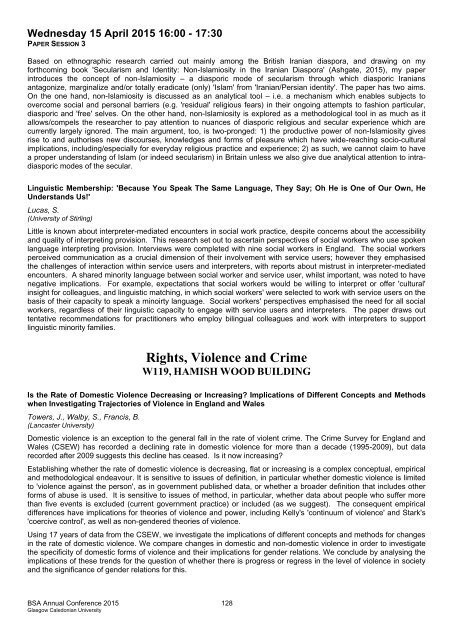Programme full
Programme full
Programme full
Create successful ePaper yourself
Turn your PDF publications into a flip-book with our unique Google optimized e-Paper software.
Wednesday 15 April 2015 16:00 - 17:30<br />
PAPER SESSION 3<br />
Based on ethnographic research carried out mainly among the British Iranian diaspora, and drawing on my<br />
forthcoming book 'Secularism and Identity: Non-Islamiosity in the Iranian Diaspora' (Ashgate, 2015), my paper<br />
introduces the concept of non-Islamiosity – a diasporic mode of secularism through which diasporic Iranians<br />
antagonize, marginalize and/or totally eradicate (only) 'Islam' from 'Iranian/Persian identity'. The paper has two aims.<br />
On the one hand, non-Islamiosity is discussed as an analytical tool – i.e. a mechanism which enables subjects to<br />
overcome social and personal barriers (e.g. 'residual' religious fears) in their ongoing attempts to fashion particular,<br />
diasporic and 'free' selves. On the other hand, non-Islamiosity is explored as a methodological tool in as much as it<br />
allows/compels the researcher to pay attention to nuances of diasporic religious and secular experience which are<br />
currently largely ignored. The main argument, too, is two-pronged: 1) the productive power of non-Islamiosity gives<br />
rise to and authorises new discourses, knowledges and forms of pleasure which have wide-reaching socio-cultural<br />
implications, including/especially for everyday religious practice and experience; 2) as such, we cannot claim to have<br />
a proper understanding of Islam (or indeed secularism) in Britain unless we also give due analytical attention to intradiasporic<br />
modes of the secular.<br />
Linguistic Membership: 'Because You Speak The Same Language, They Say; Oh He is One of Our Own, He<br />
Understands Us!'<br />
Lucas, S.<br />
(University of Stirling)<br />
Little is known about interpreter-mediated encounters in social work practice, despite concerns about the accessibility<br />
and quality of interpreting provision. This research set out to ascertain perspectives of social workers who use spoken<br />
language interpreting provision. Interviews were completed with nine social workers in England. The social workers<br />
perceived communication as a crucial dimension of their involvement with service users; however they emphasised<br />
the challenges of interaction within service users and interpreters, with reports about mistrust in interpreter-mediated<br />
encounters. A shared minority language between social worker and service user, whilst important, was noted to have<br />
negative implications. For example, expectations that social workers would be willing to interpret or offer 'cultural'<br />
insight for colleagues, and linguistic matching, in which social workers' were selected to work with service users on the<br />
basis of their capacity to speak a minoirty language. Social workers' perspectives emphasised the need for all social<br />
workers, regardless of their linguistic capacity to engage with service users and interpreters. The paper draws out<br />
tentative recommendations for practitioners who employ bilingual colleagues and work with interpreters to support<br />
linguistic minority families.<br />
Rights, Violence and Crime<br />
W119, HAMISH WOOD BUILDING<br />
Is the Rate of Domestic Violence Decreasing or Increasing? Implications of Different Concepts and Methods<br />
when Investigating Trajectories of Violence in England and Wales<br />
Towers, J., Walby, S., Francis, B.<br />
(Lancaster University)<br />
Domestic violence is an exception to the general fall in the rate of violent crime. The Crime Survey for England and<br />
Wales (CSEW) has recorded a declining rate in domestic violence for more than a decade (1995-2009), but data<br />
recorded after 2009 suggests this decline has ceased. Is it now increasing?<br />
Establishing whether the rate of domestic violence is decreasing, flat or increasing is a complex conceptual, empirical<br />
and methodological endeavour. It is sensitive to issues of definition, in particular whether domestic violence is limited<br />
to 'violence against the person', as in government published data, or whether a broader definition that includes other<br />
forms of abuse is used. It is sensitive to issues of method, in particular, whether data about people who suffer more<br />
than five events is excluded (current government practice) or included (as we suggest). The consequent empirical<br />
differences have implications for theories of violence and power, including Kelly's 'continuum of violence' and Stark's<br />
'coercive control', as well as non-gendered theories of violence.<br />
Using 17 years of data from the CSEW, we investigate the implications of different concepts and methods for changes<br />
in the rate of domestic violence. We compare changes in domestic and non-domestic violence in order to investigate<br />
the specificity of domestic forms of violence and their implications for gender relations. We conclude by analysing the<br />
implications of these trends for the question of whether there is progress or regress in the level of violence in society<br />
and the significance of gender relations for this.<br />
BSA Annual Conference 2015 128<br />
Glasgow Caledonian University


